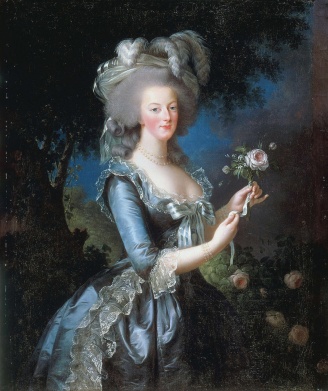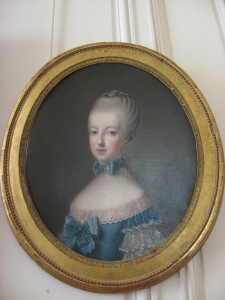
So, as I mentioned in a previous post, there is an exhibit going on right now at the Metropolitan Museum of Art in New York City highlighting the work of Elisabeth Vigée Le Brun. She was one of the most sought-after and talented portrait painters of her time, and as this previous post explains, one of her paintings played a part in the Affair of the Diamond Necklace. Vigée Le Brun painted Queen Marie-Antoinette multiple times, and her paintings were prominent in the public mind: in addition to the portrait of the

Marie Antoinette en Chemise [or “en gaulle”], 1783 by Elisabeth Vigee Le Brun. Source: Wikimedia Commons.
But Vigée Le Brun painted many more people than just Marie-Antoinette. She began painting as a young woman, was sought after among the elite of French society, escaped the French Revolution just before it exploded, moved from capital to capital painting prominent people, and continued to paint late into her life (she died at 86).
The exhibit at The Met includes 80 paintings, some of them of familiar figures to those of us familiar with late-18th-century France: Madame du Barry, the Duchesse de Polginac, Calonne, and Mesdames Adelaide and Victoire. There are also less familiar figures, some of them important men’s mistresses, some of them princes and princesses from across Europe, some of them noted intellectuals. What they all have in common, at least in Vigée Le Brun’s portraits, is a vibrancy and movement that you don’t see in many portraits. There are expressions on their faces, and they all look like they’re about to do or say something. They portraits are engaging. The commentary I listened to during my walk-through of the exhibit (I spent

Portrait of Marie Antoinette, 1783 by Elisabeth Vigee-Le Brun. Source: Wikimedia Commons.
two hours there) suggested that this was because Vigée Le Brun herself was engaging and personable, and she drew out her subjects’ personality. It’s hard to say–one suspects that a large part of it was simply her skill as an artist.
The paintings are also visually stunning. I’ve seen images of the paintings, via the Internet, but they simply don’t do justice to the originals. There is an exquisite delicacy to the way Vigée Le Brun handled fabrics, especially sheer fabrics like muslin fichus or wraps in ladies’ hair. The white dress worn by the Comtesse de La Châtre in her portrait, for instance, has delicate matte-white dots spread across the white satin fabric below. It’s a subtle but beautiful detail.
In fact, I’d say that “beauty” more or less characterizes all of Vigée Le Brun’s work. Everything she painted has a heightened elegance to it–it’s very much like arranged flowers. This wasn’t an artist interested in capturing people “warts and all”; she was interested in aesthetically beautiful paintings.
And that is more than alright by me. I’m not fond of modern art because it feels so self-indulgent; instead of creating something pleasurable, art is supposed to make us “think” (usually about humanity’s failings). I admit to just wanting a pretty picture. And boy does Vigée Le Brun deliver those!
I should also make a note of the colors: Vigée Le Brun used the most remarkable colors. They’re bright and bold and perfectly chosen. There are blues paired with golds, dramatic reds with black and white, a punch of pastel-colored flowers amid more somber grays and blues, and forest greens paired with royals blue and vibrant whites.

Comtesse de la Châtre. 1789. Source: Wikimedia Commons.
Did I mention that I adored this exhibition?
It was definitely worth the five-hour drive in the pouring rain, worth braving the streets of New York City, worth the $35 for parking and the $40 in tolls (yeah . . . the I-95 corridor is expensive!). And it was definitely worth the two hours that I spent there, drooling over the beauty of it all.
I was definitely intensely pleased when I got to see Marie Antoinette en Chemise and Marie Antoinette avec une Rose side-by-side. As the audio guide explained, it’s the first time the two have been exhibited side-by-side.
Why was I so excited? Well, again, I refer you to this post, but to give a quick overview of the story behind these paintings: Vigée Le Brun painted the portrait of Marie-Antoinette “en chemise” and presented it in public at a salon in 1783. “En chemise” means that Marie was in a white muslin or “chemise” dress. Now, a chemise was an undergarment that went beneath everything else, stays (“corset”) included. It was scandalous to show the queen in a portrait in what looked like her underclothing. It was too informal, too suggestive. So Vigée Le Brun took down that painting and quickly dashed off another one, with the queen in the same pose but wearing a more appropriate/regal blue satin gown.
In both portraits, you’ll notice, the queen is holding the same thing in her left hand: a rose. Not long after this painting was displayed, in 1785, a young adventuress named Jeanne de La Motte-Valois convinced a credulous Cardinal that she was friends with the Queen (she did it to steal a very expensive necklace). To win him over, she hired a prostitute (Nicole d’Oliva) to play the part of the queen (oh dear!), dressed her in a white muslin dress and gave her a rose to hand to the Cardinal. Sound familiar? It seems pretty likely that Jeanne got the idea from the portrait of the Queen en chemise. In fact, one of Jeanne’s friends, Jacques Claude Beugnot, remembered that Jeanne had a candy box with a copy of Marie Antoinette en chemise painted on the inside of its lid!
And of course, the reason I started this blog way back when was to tell more of this story. I’d written an entire novel about it, but I wasn’t nearly done. Yes, this blog has shifted focus, but that doesn’t mean that I don’t have an abiding interest in the Affair of the Diamond Necklace and everything related to it. I was even willing to make a harrowing trip into New York City to see this exhibition, just to get a glimpse of the originals of these two paintings. I was rewarded by more beauty than I’d even imagined. I went for the pair of paintings of Marie-Antoinette, but I stayed for the 78 other exquisite pieces of art.
(I would be lying if I said I didn’t sneak a few pictures while inside the exhibit, but I don’t want to share them on principle, and they aren’t very good anyway!)







